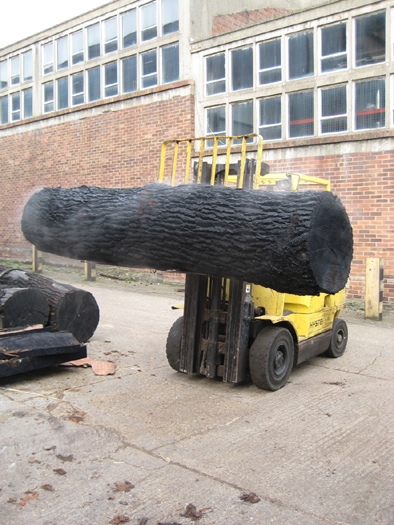Veneer
Cutting veneer is an industrial process worth understanding as it has had such a big impact on the way we use wood and in turn design and build objects. Practically everything that is wooden and industrially produced will contain a veneered component somewhere. From classic bentwood furniture to kitchen cabinets, it is evident all around us. On a recent visit to Reliance Veneers I witnessed first hand the veneer cutting process for one of the last times there.
Firstly the trees trunks were boiled in huge tanks for a couple of days to soften them up, which makes them easier to cut. When they were taken out of the water they were black like charcoal and steaming hot, the bark and the vegetation growing on the outside of the trees giving off seaweed-like smell. The trees I saw cut were a type of oak known in the trade as Pippy Oak. This refers to a sort of defect in the grain which is identified prior to the veneer being cut and has a desirable decorative figure to it. The steaming black logs were then fork-lifted to a huge outdoor band saw about the size of a bus, craned on and the blackened trunk carefully rotated and trimmed all around. This left the main body of the trunk exposed and raw looking and the undesirable blacked ends were then removed with a grinder and the trunk was then ready to be cut into veneer.
Veneer can made in different ways: It can be sliced, which cuts straight through the log and the growth rings of the tree and visually looks the same as a tree converted into boards. This method I would liken to a giant cheese slicer. The oak logs I was watching were to be rotary cut, the other method of cutting veneer, which I would liken to a pencil sharpener. This method produces visually distinct veneer as you are cutting around the core of the trunk and not through the growth rings. Practically this means you can choose to slice much wider pieces of veneer than the actual width of the tree. For example this is the way you cut the wide lengths of veneer used to make plywood. Both methods of producing veneer are very efficient uses of the tree in comparison to sawing wood into boards, as the blades slicing the wood produce no waste between cuts. Sought-after species of wood and interesting sections of trees are often made into veneer to maximize their use.
Once trimmed the still hot log was moved again into the machining warehouse. The head machinist has been working at Reliance Veneers for the past 38 years. After briefly sizing up the log, he harnessed it with a rope and gently swung it around with a crane to the rotary cutter. The machine when activated clamped into either end of the trunk with tremendous force, squeezing out hot liquid from its core. The log rotated and was slowly offered up to a razor sharp blade that peeled off thin leaves of wood with a satisfying crisp sound. The machine gradually drew the log closer to the blade so each rotation took off another slice 0.6 millimeter thick.
Seeing a tree trunk revolving horizontally in front of you is a dizzying sensation. A column big enough to hold up a floor, yet spinning around on an axis and being peeled like a doner kebab. The veneer came out of the other side of the machine amongst a cloud of sweet oak smelling steam and was laid up in bundles. Then it was dried in another machine about the size of a detached bungalow. The cutting was finished when the quality of the veneer deteriorated towards the core of the tree. What remained was a post, sometimes referred to as peeler core, the heartwood of the tree, which was left to cool, split and ooze sap.
Thanks to all at Reliance Veneer
